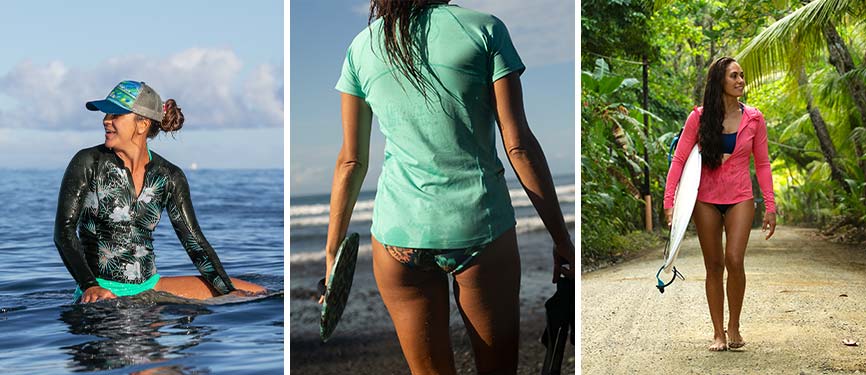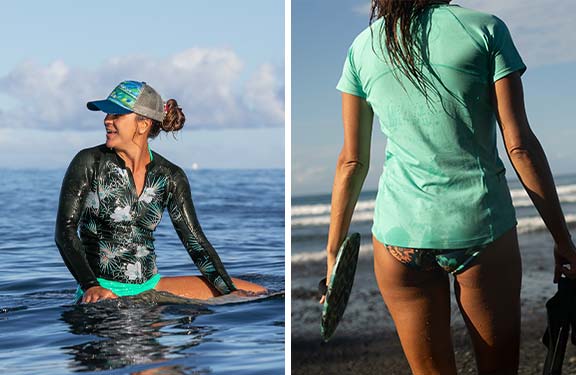When it comes to protective clothing, we often joke that "real women
bring their own protection." But as enthusiastic athletes and lovers
of the outdoors, we take it really seriously. We believe in helping
women protect their skin from harmful UV rays that may cause skin
cancer, so we make swimsuits with sun protection built in, and a
variety of other forms of sun protection clothing for all kinds of
outdoor activities.
We also believe in helping you find the right gear for whatever you're
into – and we know that sometimes it can be confusing. With that in
mind, we've pulled together your most frequently asked questions in
this FAQ, so you can find the right kind of UPF that won't wash off.
Sand, sun, surf, swim—a day at the beach can be pretty rough on your
skin. A rash guard is a form-fitting athletic shirt that’s built to
protect your skin from chafing, sunburns, and board rash. A long
sleeve rash guard shirt or a short sleeve rash guard shirt are a
perfect extra layer to add to over
tankini tops
,
one piece swim, or
two piece swimsuits.
Rashguards are made of more heavy-duty fabric than
sun shirts and swim shirts. They're more dense than swimsuit fabric, but not quite
wetsuit
fabric, giving you a just-right layer of compression and warmth when
you're in chilly water.
A rash guard for women tends to be form-fitting and sometimes even
compressive, since they’re specifically designed to be streamlined
while protecting from sun, sand, and chafing.
Other features to look for in a rash guard? They should have sun
protection (preferably UPF 50), be quick-drying, and have a zip-up
(full-zip or half-zip) option and sleeve (short sleeve or long
sleeve) option that works for you.
BACK TO TOP
Swim shirts, sometimes called surf shirts, are designed to provide
you with protection from UV radiation that won't wash off. As
swimwear, swim and surf shirts have comfortable, chafe-free seams
just like their rashguard cousins. Unlike a rashguard, however, swim
shirts tend to be more like regular clothing, providing you with UPF
50 protection in a loose fit. While this may create a bit more drag
and water flow during surf sessions, it may also be more comfortable
to wear along the boardwalk. The distinction is mostly a personal
preference.
BACK TO TOP
A sun shirt is a type of UPF clothing better suited for activities
out of the water than in it. These often have wicking properties
along with their UPF rating, but tend to have a loose fit when
compared to a rash guard or rash vest. This may make them more
comfortable to wear throughout your day, whether you are just back
from surfing and peeling off your wet suit, out for a jog, or doing
yard work under a hot sun. While these tops will protect you from
harmful UV rays, they're not designed to swim in, so they are not
limited by flattened seams and can come in a wider variety of styles
and colors, including long sleeve, short sleeve, hoodie, and
button-up.
BACK TO TOP
Will a rash guard, swim shirt, or sun shirt prevent sunburn?
All three of these types of
sun protection clothing
will help protect your skin from the harmful UV rays that can cause
skin cancer. While most of our protective clothing is made from a
UPF 50 fabric, each piece will have a UPF rating under the item
details. Keep in mind that t-shirts offer very little UV protection
– so any built-in UPF will provide more protection against sunburn
than a regular t-shirt or even a regular long sleeve shirt. Keep in
mind that sunscreen should still be worn on your face and chest, or
other areas not protected by your clothing.
BACK TO TOP
What is the difference between a swim shirt and a rash guard?
The main difference between a swim shirt and a rash guard is the
fit. Because rashguards are designed for surfing or other higher
intensity water sports, they are more like a water-ready compression
shirt. By contrast, swim shirts are designed to protect against UV
rays while also being comfortable. In other words, your size in a
rash guard will fit tighter than your size in a swim shirt. As a
result, you may feel more comfortable wearing a swim shirt or sun
shirt around town – but it's really all about personal preference.
BACK TO TOP
What is the difference between a swim shirt and a sun shirt?
Sun shirts are the most different from swim shirts or rash guards.
Unlike their swimwear cousins, sun shirts are not designed to be
submerged in water, which means they are not limited to certain
seams or shapes. They tend to have a loose and casual fit, and a
variety of styles and colors available. While you will certainly see
this swimwear in both long sleeve and short sleeve styles, sun
shirts are more versatile, and are also made in hoodie, cover-up and
button-up cuts.
BACK TO TOP
Should I get a rash guard or a swim shirt?
Well, that depends! Both rash guards and swim shirts offer
protection from the sun, so it depends what level of activity you
think you’ll be doing, what temeperature the water will be, and
whether you are looking for a compression shirt or not. Are you
looking to surf some serious swells, and comfortable in a tighter
fitting shirt, or are you more interested in taking a loose fit
seaside – for UPF sun protection that fits in on and off the board?
The choice is yours.
BACK TO TOP
Should a swim shirt be tight or loose?
If you order your size in a swim shirt, the fit should be loose and
comfortable. If you're interested in a tighter fitting sun
protection shirt, you might prefer a rash guard.
BACK TO TOP
Should rash guards be tight?
Yes and no. Rash guards should be form-fitting, since they're
designed to protect your skin from sun damage and chafage without
slowing you down. Your normal size in a rash guard should be a bit
tighter than a typical shirt. However, nothing should be too tight.
When trying on a rash guard, make sure you have a full range of
motion in your arms. It should be snug, but not uncomfortable.
BACK TO TOP
Are sun shirts and swim shirts hot?
Sun and swim shirts are designed to protect your skin from harmful
rays without overheating. They typically have wicking and cooling
properties built in. If you're looking to add warmth in the water,
you may find a better fit in a rash shirt or rash guard – which are
sometimes even made with neoprene for extra warmth
BACK TO TOP
Are rash guards hot?
Rash guards, especially long sleeve rash guards, are the warmest
type of protective clothing that we offer, but that doesn't mean
that they are hot! Most are made of the same water ready fabric as
swim shirts, though you can find them made of thin neoprene (the
same fabric used for wetsuits) if you're looking for something
warmer.
BACK TO TOP
Do rash guards have UV protection?
Every rashguard Title Nine sells is UPF-rated. (A UPF rating helps you know how much UV
protection a piece of clothing provides.) This means you can skip the sunscreen and feel
confident that your skin will be sunburn free. (But don’t forget to SPF-up the rest of you!)
BACK TO TOP
Can rash guards be used for swimming?
Of course! They are designed for swimming and surfing and all sorts
of water sports. Swim shirts are another great option, if you prefer
something more loose.
BACK TO TOP
Do rash guards protect from jellyfish?
Rash guards are a great way to provide projection from jellyfish stings, as well as burns and
rashes, to the areas of the body covered by the rash guard.
BACK TO TOP
What do you wear under a rash guard or swim shirt?
Women typically wear a
swim suit top
or
one piece swimsuit
under a rash guard or swim shirt for extra modesty. However, it's
all a matter of personal comfort. We'd recommend not going topless
under a white one, though!
BACK TO TOP
What do you wear under a sun shirt?
Like rash guards and swim shirts, you could wear a
sports bikini
top under a sun shirt. However, since these are not swimwear, you
could also wear a
sports bra,
normal bra or no bra - depending on how you intend to spend your
day!
BACK TO TOP
How long do rash guards last?
There's no definitive expiration date for your rash guard, but there are a few ways you can
maintain its quality and UPF rating after long days in the sand and sun.
Whether you just finished swimming or snorkeling, or just hopped off your surfboard, immediately
rinse your rash guard with cold, fresh water and let it air dry. Never wash your rash guard (or
any swimwear!) with hot water or in the washing machine with regular clothing. As a general
rule, we suggest washing your rash guard by hand to prevent any unnecessary damage.
Rashguard smelling a bit stinky? Soak it in cold water with one cup of baking soda overnight.
Heat, either from a hot car or a dryer, can also ruin your rashguard. So hang it up to dry, or
lay it out flat, and it'll feel like new even months after its first wear.
BACK TO TOP
Are rash guards good for hot weather?
The purpose of a rash guard isn't just for surfing. Because they have UPF 50 built in, they
protect you from the sun's harmful UV rays. Everyone, no matter what they're up to on a hot day,
benefits from wearing a rash guard.
Rash guards are typically made with lightweight, sweat-wicking fabrics like polyester, neoprene,
lycra, and spandex. These materials help prevent your body from overheating in and out of the
water, so you can enjoy your day in the sun without roughing out a rash or sunburn the next day.
You could also opt for a short sleeve rash guard instead of long sleeve rash guard to give your
skin some extra air, but you'll have to keep re-applying sunscreen wherever you're not covered.
BACK TO TOP
How are swim shirts supposed to fit?
Swim shirts are designed for swim activities, so they're meant to have a bit of a looser fit
compared to the compressive, sportier fit of a rash guard. Swim shirts are designed to be
comfortable, not skin-tight, so you can enjoy your time in the water. Long sleeve or short
sleeve, you really can't go wrong. Plus, since they're fast-drying, they're comfortable to wear
around town.
BACK TO TOP
































